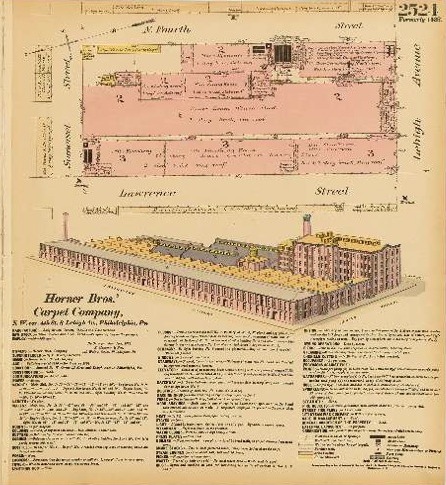
"Horner Bros.' Carpet Company." (1892), Hexamer #2524.
Quaker Lace Company, 1894
Northwest Corner of 4th Street and Lehigh Avenue, Philadelphia PA 19133
© Carmen A. Weber, Irving
Kosmin, and Muriel Kirkpatrick, Workshop of the World (Oliver
Evans Press, 1990).
In 1894, Joseph H. Bromley
purchased the Horner Brother Carpet Company mill,
constructed in 1880 and situated on the northwest corner
of 4th Street and Lehigh Avenue. The Horner Brothers
Company possessed twenty-one Nottingham lace curtain
looms. Bromley added more looms, equipment, and skilled
labor with the help of Sir Ernest Jardine of Nottingham,
England and the Lehigh Manufacturing Company began
production, rebuilding one of the Horner mill brick
buildings along 4th Street and adding several stories to
the brick building along Lawrence Avenue. By 1896,
approximately one hundred and eight Nottingham lace
curtain looms were operating in the mill.
1
In the early twentieth century, the firm expanded by
constructing additional facilities at 22nd Street and
Lehigh Avenue and incorporated under the name Lehigh
Manufacturing Company in 1905. At that date the complex
at 4th and Lehigh consisted of an office building
mid-block, with the mill buildings on either side and to
the rear of the block. The terra cotta detailing was
added later. The mill on the corner of 4th and Lehigh
contained a packing area on the ground floor, with
spooling on the second floor, and drafting, design, and
other storage areas on the upper floors. The four story
brick building behind this mill held facilities for
beaming and reeling, as well as drying and storage. The
one story brick building behind the office, with its
sawtooth roof, provided an ideal space for mending. The
Jacquard looms for making lace were on the second through
fourth floors of the Lawrence Street building, with
finishing, bleaching, and drying operations on the first
floor. 2
Today the looms
stand unused on the second floor, while the finishing and
other operations continue to be conducted on the first
floor and the design department operates in the office
building. 3
Quaker Lace was incorporated in 1911. Eighty looms
operated at the 4th Street mill, with 46 looms and 48
Levers lace machines operated at the 22nd Street mill. In
1925, the 22nd Street building was sold to the Quaker
Hosiery Company, and operations shifted to the 4th Street
mill. John Bromley was elected President of the firm in
1926. The company first added tablecloths to their line
in 1932. 4
During World War
II, Quaker Lace made camouflage nets for the military.
With the drop in demand for lace curtains after the war,
the firm made tablecloths almost exclusively, a product
they still produce and for which they are
famous.
The business changed in the late 1960s with the invention
of knitting machines capable of making lace. The older
Jacquard looms in the 4th Street mill ceased operation in
1987. Quaker Lace maintains a plant in Maine that still
weaves Nottingham lace on the older looms, as well as a
newer plant with more modern knitting machines in
Lionville, Pennsylvania. 5
1 Quaker Lace
Company, "Dates
in Quaker History," Typescript 1983, (copy on
file, Philadelphia Historical Commission).
2 Associated Mutual
Insurance Company, Index No. 1228, Survey No. 6548,
surveyed and drawn by W. L. Blossom, (Philadelphia, 1903,
copy on file, Philadelphia Historical Commission).
3 Interview with Richard
Fees, Director of Design, (May 17, 1989).
4 Quaker Lace Company.
5 Richard Fees, (May 17,
1989).
Update May
2007 (by
Torben Jenk):
Soon after being sold by the Bromley family, the building
was destroyed in a spectacular fire and then demolished.
Now the site of the Julia De Burgos Middle
School.
See
also:
Hexamer General Survey #1538 (1881) "Horner
Bros.' Carpet Mills."
Hexamer General Survey #2524 (1892) "Horner
Bros.' Carpet Company."